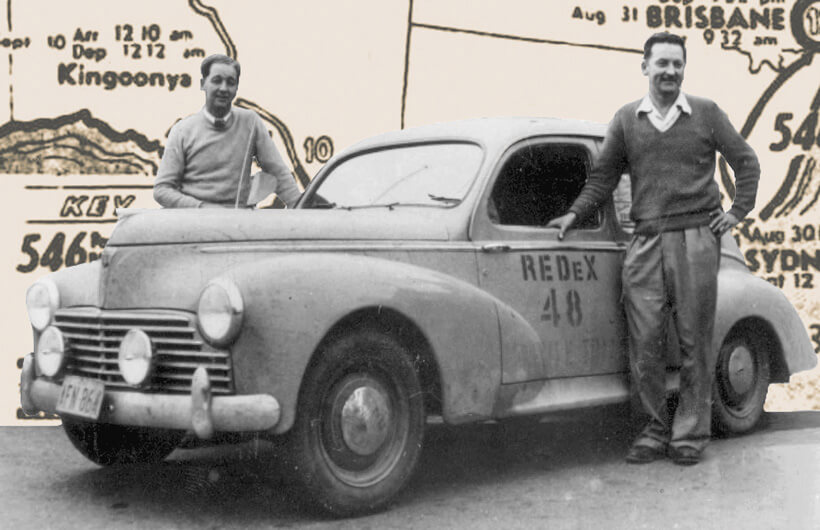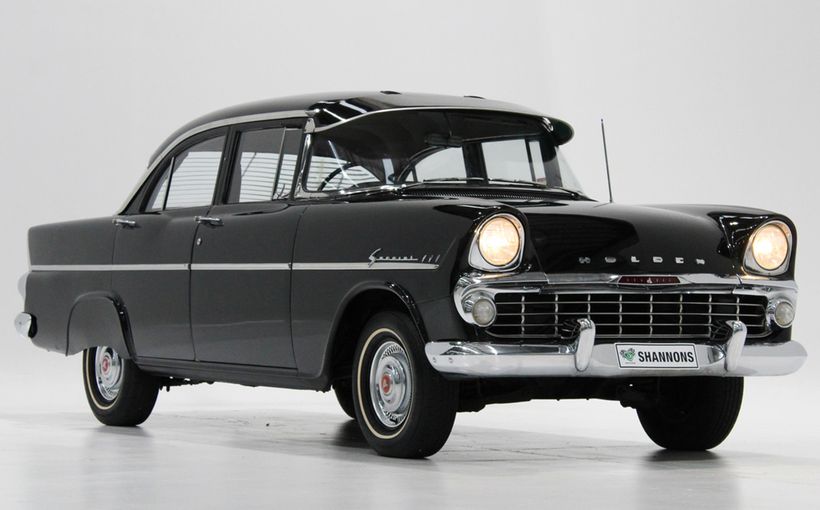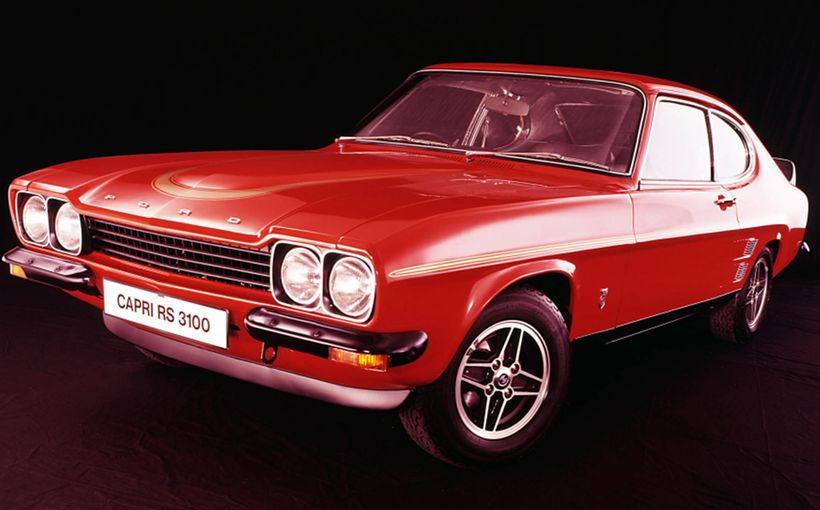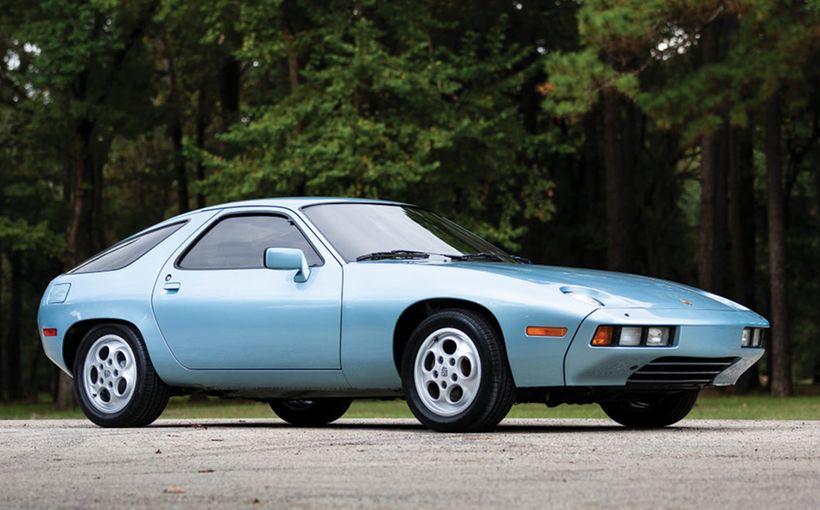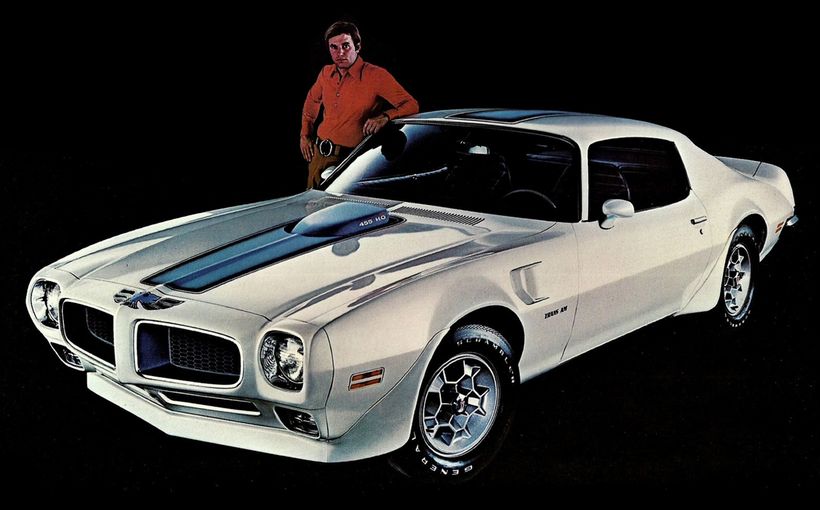Peugeot 203 & 403: Redex Trial, Ampol Trial and ‘Great Race’ Legends

Ken Tubman (right) and co-driver John Marshall with the brilliant Peugeot 203 in which they won the 1953 Redex Trial. Their historic victory generated huge publicity for Peugeot and put the little-known French brand firmly on the map in Australia. Image: www.redexrerun.wordpress.com
The Peugeot 203 and 403 firmly established the French firm as one of the world’s finest post-war car manufacturers in the 1950s and ‘60s. Their mechanical endurance and enviable ability to travel quickly over rough roads and vast distances with great comfort built a legion of loyal customers, particularly in Australia where success in the Redex Trial and Armstrong 500 proved they were ideally suited to our harsh conditions.
This was because Peugeot (like Citroen and Renault) had to build cars that could cope not only with the bumpy roads of rural France and Europe, but also the brutal terrain often encountered in the nation’s numerous far-flung colonies in northern Africa, the West Indies and islands of the South Pacific.
Peugeot could not have asked for a more authentic and credible demonstration of its peerless engineering than the famous victory by Ken Tubman and John Marshall in the 1953 Redex Trial. They drove a stock standard 203 sedan in the iconic event, which spanned the-then unfathomable distance of 6,500 miles (10,458km) across a continent renowned for its deplorable road network.
And three years later a couple of graziers from the Riverina, Wilfred Murrell and Allan Taylor in their Peugeot 403, won the first Ampol Trial held over a similar distance. The 403 also starred in the first Armstrong 500 at Phillip Island in 1960 and triggered a controversy which simmered away for decades before it was resolved.

Ken Brigden was a prominent Peugeot 403 racer in the early 1960s, taking part in numerous races including the first Armstrong 500 at Phillip Island. Here Ken’s in full flight on the spectacular Catalina Park circuit at Katoomba in the NSW Blue Mountains in 1962.
Peugeot 203: A French ‘Humpy’ Holden?
Any discussion about the 203’s success in Australia, particularly the famous Redex Trials of the mid-1950s, begs comparison with ‘Australia’s Own Car’ - the original 48-215 Holden. Not only because these Holdens were the pace setters for much of the 1953 Trial but also because there are a number of similarities between the iconic French family sedan and its local equivalent.
The venerable Peugeot model, produced from 1948 to 1960, certainly had a more contemporary and slipstreamed look than the Holden, but their key dimensions were remarkably close. The 203’s wheelbase (2580mm) was only 36mm shorter than the Holden’s (2616mm). The French car was also just 50mm shorter, 82mm narrower, 75mm lower and about 90kg lighter.
They both shared light but strong unitary body construction with independent front suspensions and live rear axles. However, the 203 used a simple transverse leaf spring with wishbones at the front in contrast to Holden’s upper and lower wishbones with coil springs. The Peugeot also used supple, long-travel coils and a Panhard rod in the rear as opposed to Holden’s more basic leaf springs.

The Peugeot 203 could be seen as France’s version of Australia’s first Holden, as they shared similar dimensions. The 48-215 and FJ ‘Humpy’ Holdens were fast and rugged performers in the Redex Trials, although victory proved elusive. Image: www.holtsauto.com
Under the 203’s bonnet beat a small but highly efficient heart in the form of a free-revving oversquare 1290cc inline four. With 6.8:1 compression and a cross-flow head with hemispherical combustion chambers, it was efficient and robust. Matched with a column-shift four-speed gearbox, by 1952 the 203 was producing 44bhp and an advertised top speed of 75mph (120km/h). This output compares favourably with the heavier Holden and its 2171cc inline six, with 60bhp, column-shift three-speed gearbox and a slightly higher top speed of 80mph (128km/h).
Such a comparison is important in this context, as these Peugeots were often perceived as being small cars when in fact they almost mirrored the key external dimensions of the ‘big’ Australian Holden. And the 203s boasted several superior design and engineering attributes.

The 1953 Redex Trial captured the Australian public’s imagination. Covering such an enormous distance in less than a fortnight, driving standard road cars across some of the world’s harshest terrain, seemed an impossible task. Image: www.picsandstuff.wordpress.com
1953 Redex 6500-Mile Car Reliability Trial
Redex was a UK fuel additive which when squirted into your petrol tank at each refill was claimed to improve your engine’s performance and overall health. However, to get this message through to the average Aussie motorist and make it the quintessential part of 1950s motoring culture that it soon became, required some big picture thinking by UK-born sales manager Reg Shepheard.
The Australian Sporting Car Club (ASCC) was appointed organiser of the unprecedented 6,500 mile (10,458km) marathon which Redex claimed was the longest car trial to be held since the famous New York-Paris event back in 1908. Starting in Sydney, the field would head north to Townsville then tackle a massive outback loop through Mount Isa, Darwin, Tennants Creek, Alice Springs and Kingoonya. It would then pass through Adelaide, Melbourne, Albury before returning to Sydney 13 days later.
Competitors would lose one point per minute for arriving at controls either early or late, with much bigger penalties for not obeying officials or replacing components. This was, after all, a test of reliability. Competing cars had to be stock standard apart from extra equipment like auxiliary fuel tanks, bull bars etc.
“Consider if you will, the potential the event had for capturing the public imagination,” wrote Bill Tuckey in his wonderful book From Redex to Repco. “It is difficult to explain to anyone who was not around in 1953. But in 1953 it was inconceivable that anyone could drive a standard motor car around Australia. A trip from Sydney to Brisbane or Melbourne was a two-day expedition. There were no motels. Most main roads away from the Hume and Pacific Highways were unsealed. There were gaps of perhaps 1000 kilometres between fuel points (Shell laid down petrol dumps of 32,000 gallons in four-gallon drums around 5000 kilometres between Townsville and Adelaide for the trial). Out there was the unknown. The 1953 Redex Trial had all the air of an enormous adventure and for months people talked about little else.”

Tubman and Marshall in their invincible Peugeot 203 arrive in Sydney late in the evening on September 12 to claim victory in the 1953 Redex Trial. Note the extra pair of driving lamps and the simple but effective ‘aero’ bug deflector on the bonnet, designed to stop insects from hitting the windscreen at speed. Image: www.inveralltimes.com.au
The first Redex Trial attracted a staggering 192 entries, which included a huge variety of brands and some factory and/or dealer backed ‘works’ teams with top drivers, headed by Lex Davison, Stan Jones and Charlie Dean in a three-car team of 48-215 Holdens backed by Preston Motors. There was also a three-car Humber Super Snipe entry backed by the Rootes Group. Other notables were Jack Brabham (Austin A40), ‘Gelignite’ Jack Murray and Peter Antill (Chrysler Plymouths), Eddie Perkins (Rover 75), Norman Hamilton (Porsche 356) plus radio star Jack Davey and multiple AGP winner Doug Whiteford both in Ford Customlines.
“Nobody took much notice of Car No.48, with a crew of Ken Tubman and John Marshall,” Tuckey wrote. “The car was a funny little Peugeot 203, French, little known, small in an era when everybody knew that the big Snipes and Plymouths and Customlines were the cars to go around Australia. Still, there enough 203s entered – 11 all told, which said something.
“’Tubby’ – the name fitted the sillouhette – was a serious rally driver then, at the age of 37. He had been in circuit racing since 1946 with an MG K3, the ex-AGP winner Bill Thompson’s car, six cylinders supercharged and 200km/h on call. His first trial, in 1946, was in a 1939 Buick. All they did for the Redex was to give the Peugeot a valve grind, lube, throw in a few spares and pack in a dozen bottles of beer and a dozen wine given to them by a Maitland hotel owner. Tubman and Marshall were there to have fun.”
On August 30, 1953 a total of 187 cars left the Sydney Cricket Ground on this great journey into the unknown. Despite the poor state of our national roads, many crews including Tubman/Marshall in the Peugeot 203 managed to avoid any point penalties – ‘clean-sheeting’ as it was known - all the way up the east coast to Townsville in Far North Queensland.

The 203 proved to be an ideal competitor for marathon outback events like the Redex Trials. It also earned many loyal owners in the bush, who stuck with the French brand through later models like the 403, 404 and 504. Image: www.forum-auto.com
It was from here that the field would plunge west into the outback where Redex organisers included the first of two horror stretches designed to sort the men from the boys. It was a dreadful route; 609 miles (980km) to the mining town of Mount Isa. According to local legend, the fastest known time for such a demolition derby was 16 hours 45 minutes. Peter Antill in his Chrysler Plymouth cleaned it in just 13 hours 22 minutes!
The road to Mount Isa looked like a wrecking yard. Only 138 cars remained from the 187 which had left Sydney and ahead of them lay another 1098 miles (1766km) north-west to Darwin on a narrow, pot-holed patchwork of a bitumen road often used by the Army. From Darwin the field headed south through the heart of the Northern Territory to Alice Springs via Tennants Creek; 978 miles (1573km) down the infamous Stuart Highway.
The next stage from Alice Springs south to Kingoonya in South Australia was considered the second horror stretch which the event organisers were sure would sift out a winner. It was 638 miles (1021km) of unsealed road, throwing up everything from sticky red clay to deep sand drifts, bulldust and corrugations so bad they’d shake instruments out of dashboards and rattle fillings out of teeth.
From Kingoonya the survivors were only allowed a short rest before covering another gruelling 424 miles (682km) to Adelaide. Thousands of cheering spectators lined the streets of the South Australian capital as the fastest crews rolled in, of which 11 (including the Tubman/Marshall Peugeot) were still without loss of points.

No surprise that the trusty 203 proved a popular choice for Redex Trial competitors after its 1953 win. This is the Ron Green/Keith Wilson entry for the 1954 event. Compare the amount of special equipment on this car to Tubman’s 1953 winner, which had minimal pre-event preparation and looked almost naked by comparison. Image: www.forum-auto.com
First into Adelaide was Lex Davison after two marathon stints behind the wheel of his equally exhausted 48-215, now with only second gear left, followed by Kipling (Holden 48-215) and Perkins (Rover 75). And in fourth place the perpetually cheery Tubman and Marshall with their little known French car looking unbreakable, decades before Toyota adopted that word to describe its Hilux.
“Their only troubles were a few punctures between Kingoonya and Adelaide and a blocked fuel filter shortly after leaving the refuelling point at Kingoonya,” reported Wheels magazine. According to Tubman, the blockage had been caused purely by carelessness, because they had splashed in the fuel any old way which brought some dust and dirt in with it. In Adelaide, a smiling Tubman also said that he would willingly keep going around the course until everyone else fell out with fatigue!
The Redex Trial organisers now had a big problem. Despite their best efforts with horror stretches and ‘impossible’ time limits, there were still 11 crews in the event which had not dropped a point. And with nothing but bitumen all the way to Sydney, they needed a tie-breaker. Just before the crews left Melbourne, they were handed details of a last minute ‘special stage’ near Goulburn, NSW. It was an old stock route between Marulan and Bowral; less than 20km in length but a true horror stretch all the same.
Tuckey: “It had been raining in the area, and the faint, almost virgin track was greasy; at one stage it went through a metre-deep creek crossing. Everyone lost points, but least Tubman and Marshall who cruised down the bitumen to Sydney with 19 points lost. Robinson Snipe second (20), Antill Plymouth third (21), Davison fourth (22).”

Another 203 doing what it did best, hammering through the Aussie wilderness in one of the Redex Trials. The French car’s victory in 1953 was backed up by a close second place in 1954 and another win (although provisional) in the final Redex Trial held in 1955. Image: www.clubvw.org.au
Incredibly, 136 of the 187 cars which had left Sydney in August 30 returned on September 12. The survival rate was far higher than anyone had expected, although not all crews completed the entire route. The 203 not only won the first Redex Trial; of equal significance was that all but one of the 11 Peugeots entered made it to the finish.
Suddenly everyone was talking about the little-known French car which had conquered the Redex, but it didn’t stay little-known for long. And what became of the 24 bottles of wine and beer which accompanied the winners on their history-making journey?
“We didn’t drink it all,” Tubman told Wheels. “We had two bottles of beer left at the finish. But on the hot finishing day these two lonely, much travelled bottles were quickly sent off.”
Wheels stated that inadequate shock absorbers had emerged as the weakest link on most cars. That was unless you drove a Peugeot 203, for which the French company designed and built its own shock absorbers to ensure ride quality and handling were not compromised by inferior aftermarket brands.
It was that commitment to engineering excellence which ensured another stellar performance by the 203 in the 1954 Redex Trial, which covered a much longer distance of 9,600 miles (15,446km). This time Tubman was out of luck; his 203 suffered diff trouble and retired in Darwin. However another 203 driven with great determination by Bill Patterson came within eight points of beating the amazing ‘Gelignite’ Jack Murray in his 1948 Ford V8 sedan, which did not drop a point the whole way.
The Peugeot 203 also starred in the third and final Redex Trial held in 1955 in which more than 200 crews entered, 176 started and only 57 finished. Carl Kennedy was declared the provisional winner in his 203 but eventually dropped to fifth, after a series of appeals resulted in some crews initially excluded on technical grounds having their results reinstated.

The Peugeot 203’s popularity in long distance rallying was not confined to Australia. The French sedan was also a favourite with private teams in notoriously tough events like the annual Coronation Safari Rally (later renamed East African Safari) which like the Redex was first held in 1953. Image: www.luc.devroye.org
Peugeot 403: Trying to improving on perfection
The much-loved 203’s successor was the equally revered 403, which remained in production with only minor changes from 1955 to 1966. In that time more than 1.2 million 403s were produced in a variety of configurations (wagons, convertibles, utes and vans) making it the first Peugeot model to exceed one million units.
The 403 featured handsomely modern ‘ponton’ (fully-enclosed) styling by Pininfarina, on a wheelbase that was 80mm longer than the 203. It was also 120mm longer overall, 50mm wider and 10mm taller but beneath those stylish Italian lines were the same powerful braking, rugged long travel suspension and astounding rough road ride quality.
The 403’s kerb weight of 1080kg was an increase of around 150kg but to compensate for that the 203’s 1290cc ‘Hemi’ inline four was increased to 1468cc, raising output to 65bhp (48kW). A column-shift four-speed all-synchro gearbox continued to feed power to the coil-sprung live rear axle featuring Peugeot’s signature worm-and-wheel differential design.

Boys from the bush. Graziers Wilfred Murrell and Allan Taylor in their Peugeot 403 picked up where the 203 left off with outright victory in the 1956 Ampol Trial. By then Peugeot’s glowing rough road reputation was well established, particularly among Aussies like these blokes living in remote areas. Image: www.nextcar.com.au
1956 Ampol Trial
A couple of Riverina graziers, Wilfred Murrell and Allan Taylor, won the first Ampol Trial in a Peugeot 403. Although the first Ampol at 6,500 miles (10,460km) was every bit as tough and enervating as the Redex Trials had been, the 403’s victory has never been as widely publicised or appreciated largely due to an ugly split that occurred in the sport at the time.
It was triggered by a dispute between two major oil companies, Ampol and Mobil, over the naming rights sponsorship of the 1956 Trial following Redex’s withdrawal. Without going into the politics of it all, the end result was two major round-Australia trials being run by two rival governing bodies within weeks of each other. Confusion over which was the ‘real’ event served only to confuse the public and competitors resulting in fading media, spectator and commercial interest.
The 1956 Ampol Trial ran for 14 days, starting in Sydney but heading in a clockwise direction this time via Melbourne, Adelaide, Alice Springs and Tennant Creek before heading east to Mount Isa, Cairns, Townsville, Brisbane and back to Sydney. It was hellishly tough, with only 34 of the original 113 starters reaching the finish. An ideal event for the mighty 403, which was able to build on Peugeot’s glowing reputation in Australia.

The Peugeot 403 shared by Geoff Russell, David Anderson and Tony Loxton performed superbly in the 1960 Armstrong 500, running away with Class C and finishing second outright behind the Class D Vauxhall Cresta with greater power and speed.
1960 Armstrong 500
The first Armstrong 500 held at Victoria’s Phillip Island in 1960 was an event almost tailor-made for the 403, as the brittle bitumen track surface started to break up during the race and resembled a miniature round-Australia trial course by the end of 500 miles (800km).
The bumper field of 47 stock standard cars was spread across five classes comprising Class A (up to 750cc), Class B (751-1300cc), Class C (1301-2000cc), Class D (2001-3500cc) and Class E (over 3500cc). These represented a diverse mix of car brands available in Australia, with the Peugeot 403’s competition in Class C coming from an all-British line-up including Morris Major, Austin Lancer, Singer Gazelle and Hillman Minx.
Speedy Tasmanian brothers John and Gavin Youl in their Mercedes 220SE led Class D and held the outright lead (even though no outright winner was crowned in those early days), building more than a lap’s buffer over the field. However, as the track started to fall apart, their mercurial Mercedes punctured a tyre and barrel-rolled.

All three Peugeot 403s entered for the first ‘Great Race’ at Phillip Island in 1960 finished the event, even though the brittle bitumen circuit looked more like a bomb site by the end of it. This is the Ron Lillie/Jim Gullan 403, generating plenty of body roll (!) on its way to eighth place in Class C.
That left the lone Vauxhall Cresta driven by Frank Coad and John Roxburgh in a commanding lead in both Class D and outright. After 167 laps and almost eight and half hours of racing, their bruised, battered and bug-splattered Cresta crossed the finish line to an enthusiastic reception from the 40,000-strong crowd. Only 35 of the original 47 starters were still circulating at the finish.
The runaway winner of Class C and in second place outright was the Peugeot 403 driven by Geoff Russell, David Anderson and Tony Loxton. This car and its official race result at the time (167 laps completed) were to be the focus of much controversy for more than three decades, with many claims that it was in fact the outright winner. These disputes were common when official lap scoring was done manually with volunteers using stop watches, paper and pen.
The issue was finally laid to rest in 1992 when Graham Hoinville, a respected race and rally driver/navigator working for the Confederation of Australian Motor Sport (CAMS) at the time, did a forensic breakdown and analysis of every lap of the race including pit stops. He basically re-ran the race and concluded beyond debate that the winning Vauxhall completed its final lap (167) only seconds after the Peugeot commenced its 164th lap.

Cars competing in the Armstrong 500 really were showroom stock. Here the Norm Beechey/John French Standard Vanguard (second in Class D) leads the Ray Christie/George Hughes Simca Aronde (dnf) and Bob Holden/Ken Bridgen 403, which finished fourth in Class C.
In any case, it was still an outstanding performance by the Peugeot 403 in completing more laps than any other car in the race bar the winner, with its much larger engine and superior speed. The French car also smashed its British rivals in Class C, finishing five laps ahead of the second-placed Morris Major.
The wide-held respect and adoration for the Peugeot 203 and 403 by French car fanatics today is not hard to understand, particularly in Australia. Given their achievements in some of the toughest tests of automotive endurance, such enviable reputations have been well-earned.

